TRAVEL GUIDANCE
YAKUSHIMA FOOD
Plenty of produce all year round
One of the main reasons to visit anywhere in Japan is to sample the local delicacies and Yakushima has wide range of its own produce that should be sampled.
Ponkan & Tankan
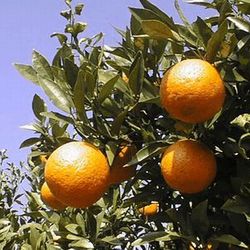 The ponkan is an easily peeled, sweet variety of orange They arrived on Yakushima from Taiwan in the 1920’s. The even sweeter and juicier tankan arrived in the 1950’s. Both crops helped to re-vitalise the agricultural industry after the Pacific War. Orange orchards can be found around most areas of the island, but the main orange area is in the south. However, the people of Nagata (north west) would declare that they have the tastiest oranges as they have a cold weather front hitting their village in the winter just before the oranges are harvested and this increases their sweetness. The oranges are a major export of Yakushima. If you visit in the winter or early spring keep your eyes peeled (pun intended) for bags of oranges for 100 yen at the roadside markets.
The ponkan is an easily peeled, sweet variety of orange They arrived on Yakushima from Taiwan in the 1920’s. The even sweeter and juicier tankan arrived in the 1950’s. Both crops helped to re-vitalise the agricultural industry after the Pacific War. Orange orchards can be found around most areas of the island, but the main orange area is in the south. However, the people of Nagata (north west) would declare that they have the tastiest oranges as they have a cold weather front hitting their village in the winter just before the oranges are harvested and this increases their sweetness. The oranges are a major export of Yakushima. If you visit in the winter or early spring keep your eyes peeled (pun intended) for bags of oranges for 100 yen at the roadside markets.
The ponkan harvest is in December and the tankan harvest is from February – March.
Flying Fish (tobio - トビウオ)
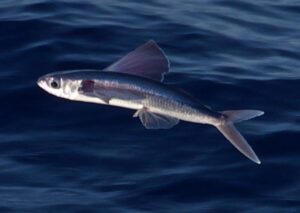 At some point during your stay in Yakushima you will undoubtedly be served flying fish. If you’re not sure, just check if your fish has wings or not! The flying fish are called tobio (トビウオ), but the local word for them is toppy (hence the name of the jet foil ferry). The flying fish in Japan are caught year-round, but the peak fishing season is from late spring to early summer. The flying fish industry is based in Anbo. Flying fish are served as sashimi, salt grilled or deep fried with their wings fried and crispy. There was a time when these fish could be caught very easily along the shores of the island as the flying fish used the shade of the pine trees to spawn their eggs. However, gradually the trees from the coastal area disappeared, along with an increase of pollution emanating from the rivers during the height of the logging period and so the flying fish left the coastal region of the island and now the fishermen have to travel much further out to open water to catch the fish. The method of catching the flying has changed over the centuries and the most remarkable method was introduced from a group of migrants about a 100 years ago from an island further south of Yakushima.
At some point during your stay in Yakushima you will undoubtedly be served flying fish. If you’re not sure, just check if your fish has wings or not! The flying fish are called tobio (トビウオ), but the local word for them is toppy (hence the name of the jet foil ferry). The flying fish in Japan are caught year-round, but the peak fishing season is from late spring to early summer. The flying fish industry is based in Anbo. Flying fish are served as sashimi, salt grilled or deep fried with their wings fried and crispy. There was a time when these fish could be caught very easily along the shores of the island as the flying fish used the shade of the pine trees to spawn their eggs. However, gradually the trees from the coastal area disappeared, along with an increase of pollution emanating from the rivers during the height of the logging period and so the flying fish left the coastal region of the island and now the fishermen have to travel much further out to open water to catch the fish. The method of catching the flying has changed over the centuries and the most remarkable method was introduced from a group of migrants about a 100 years ago from an island further south of Yakushima.
Mackerel (saba - サバ)
Smoked Mackerel (kunsei saba – 燻製・サバ)
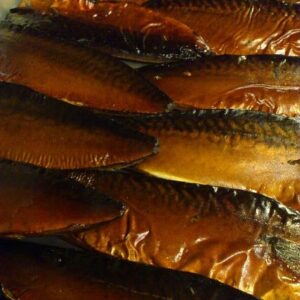 The mackerel fishing industry is based in Isso in the north of the island. The mackerel variety caught locally is the spotted chub mackerel. This species contains less fat than common chub mackerel. Yakushima has several mackerel smoking plants, the oldest of which is over 200 years old and is located by the river in Isso. Dried, smoked mackerel is sold vacuum-packed and is a popular souvenir with Japanese tourists. ‘Saba bushi’ is also produced. The mackerel are first smoked and then dried. A natural mold is encouraged to form which gives the dried mackerel a distinctive flavour. The dried mackerel is either shaved or ground into a powder for use in noodle stock.
The mackerel fishing industry is based in Isso in the north of the island. The mackerel variety caught locally is the spotted chub mackerel. This species contains less fat than common chub mackerel. Yakushima has several mackerel smoking plants, the oldest of which is over 200 years old and is located by the river in Isso. Dried, smoked mackerel is sold vacuum-packed and is a popular souvenir with Japanese tourists. ‘Saba bushi’ is also produced. The mackerel are first smoked and then dried. A natural mold is encouraged to form which gives the dried mackerel a distinctive flavour. The dried mackerel is either shaved or ground into a powder for use in noodle stock.
Broken-necked Mackerel (kubi ore saba – 首折れサバ)
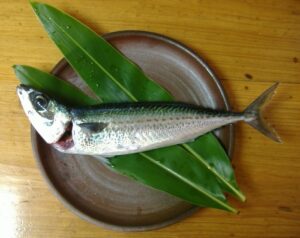 Mackerel is a fish that spoils quickly so only the freshest fish can be eaten raw as sashimi or sushi. To preserve the freshness, the Yakushima fishermen have a traditional method of breaking the mackerel’s neck as soon as it has been caught. Broken-necked mackerel (kubi ore saba) are a Yakushima delicacy and are usually eaten as sashimi. When ordering kubi ore saba, the fish is usually brought to the table with the neck clearly at a raised angle – indicating the method the fish was killed.
Mackerel is a fish that spoils quickly so only the freshest fish can be eaten raw as sashimi or sushi. To preserve the freshness, the Yakushima fishermen have a traditional method of breaking the mackerel’s neck as soon as it has been caught. Broken-necked mackerel (kubi ore saba) are a Yakushima delicacy and are usually eaten as sashimi. When ordering kubi ore saba, the fish is usually brought to the table with the neck clearly at a raised angle – indicating the method the fish was killed.
Shochu Liquor (shochu – 焼酎)
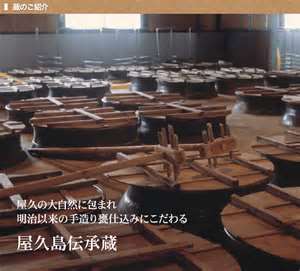 Shochu is a clear, distilled Japanese liquor with its origins coming from Korea / China. It can be made from a variety of ingredients, but on Yakushima it is usually made from sweet potatoes. Like whisky, the quality of shochu is dependent on the quality of the water. Therefore, Yakushima is renowned for the quality of its shochu as the island has a wonderful `soft` water. Shochu, rather than nihonshu (rice winie) is the traditional drink of choice in the southern regions of Japan (Kyushu – Okinawa). When distilled it is around 40% alcohol, but the popular brands are diluted to a more palatable 25%. Shochu has a ‘stronger’ flavour and aroma than traditional nihonshu (which is made from rice). The popular way to drink shochu is to mix it with water if the alcohol content is too strong. In the winter you can ask for it ‘oyuwari’ (with hot water) and in the summer time ‘mizuwari’ (with cold water). Or you can simply enjoy it on the rocks. A traditional distillery in Anbo offers tours around the factory with tasting sessions afterwards.
Shochu is a clear, distilled Japanese liquor with its origins coming from Korea / China. It can be made from a variety of ingredients, but on Yakushima it is usually made from sweet potatoes. Like whisky, the quality of shochu is dependent on the quality of the water. Therefore, Yakushima is renowned for the quality of its shochu as the island has a wonderful `soft` water. Shochu, rather than nihonshu (rice winie) is the traditional drink of choice in the southern regions of Japan (Kyushu – Okinawa). When distilled it is around 40% alcohol, but the popular brands are diluted to a more palatable 25%. Shochu has a ‘stronger’ flavour and aroma than traditional nihonshu (which is made from rice). The popular way to drink shochu is to mix it with water if the alcohol content is too strong. In the winter you can ask for it ‘oyuwari’ (with hot water) and in the summer time ‘mizuwari’ (with cold water). Or you can simply enjoy it on the rocks. A traditional distillery in Anbo offers tours around the factory with tasting sessions afterwards.
The most popular brand of Shochu on Yakushima is Mitake (三岳). However, the Hombo Distillery make a smoother and refined selection of shochu, and their method of production is more traditional and less industrious than the Mitake Distillery. The YES Island Tour sometimes takes guests around the Hombo Distillery, but advanced bookings are required.
Sweet Potatoes (annou imo – 安納芋)
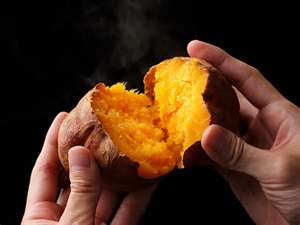 The neighbouring island Tanegashima (種子島) is nationally famous for its ‘annou imo’ sweet potatoes (the potato arrived to Japan through Tanegashima), but as Yakushima is so close to Tanegashima then it’s no surprise that Yakushima also grow some tasty sweet potatoes (the island monkeys also agree with this statement). The more common variety of sweet potato is called satsuma imo (さつま 芋), but the locally grown golden coloured annou imo is sweeter. Sweet potatoes are harvested from autumn until early winter. Sweet potatoes can be eaten simply roasted in their jackets ‘yaki imo’, made into cakes or sweets or as tempura.
The neighbouring island Tanegashima (種子島) is nationally famous for its ‘annou imo’ sweet potatoes (the potato arrived to Japan through Tanegashima), but as Yakushima is so close to Tanegashima then it’s no surprise that Yakushima also grow some tasty sweet potatoes (the island monkeys also agree with this statement). The more common variety of sweet potato is called satsuma imo (さつま 芋), but the locally grown golden coloured annou imo is sweeter. Sweet potatoes are harvested from autumn until early winter. Sweet potatoes can be eaten simply roasted in their jackets ‘yaki imo’, made into cakes or sweets or as tempura.
Green Tea ( – 煎茶)
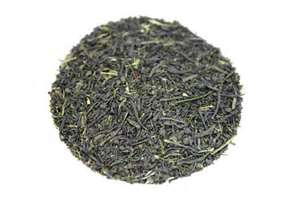 The east side of the island, around the airport area of Koseda, Nagamine & Anbo is where you’ll find most of the tea fields. The tea fields are not usually visible from the main road, but should you venture into the hills around this area there are fields and fields of low-lying, beautifully manicured tea bushes. The YES Island Tour usually takes guests around the tea fields to explain it`s history and production process. Heading south just past the airport is an organic green tea shop that sells a variety of Yakushima produced teas and some wonderful green tea ice cream (300 yen).
The east side of the island, around the airport area of Koseda, Nagamine & Anbo is where you’ll find most of the tea fields. The tea fields are not usually visible from the main road, but should you venture into the hills around this area there are fields and fields of low-lying, beautifully manicured tea bushes. The YES Island Tour usually takes guests around the tea fields to explain it`s history and production process. Heading south just past the airport is an organic green tea shop that sells a variety of Yakushima produced teas and some wonderful green tea ice cream (300 yen).
Tumeric (gajutsu – がじゅつ)
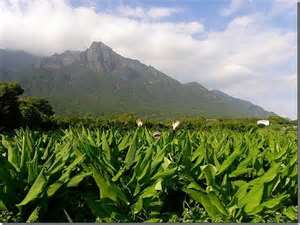 One of the oldest names for Yakushima was ‘薬島’ pronounced Yakushima, but with the Chinese kanji meaning `Medicine Island`. This was due to the variety of medicinal plants naturally growing on the island. A variety of tumeric known as ‘gajutsu’ is widely grown and harvested at different times of the year as a medicinal plant. It is used in pharmaceuticals as a powder to aid digestion and sooth stomach problems. It is found in various places on the island. This is perhaps the oldest `cash-crop` on Yakushima and is known to have been grown more than 400 years ago.
One of the oldest names for Yakushima was ‘薬島’ pronounced Yakushima, but with the Chinese kanji meaning `Medicine Island`. This was due to the variety of medicinal plants naturally growing on the island. A variety of tumeric known as ‘gajutsu’ is widely grown and harvested at different times of the year as a medicinal plant. It is used in pharmaceuticals as a powder to aid digestion and sooth stomach problems. It is found in various places on the island. This is perhaps the oldest `cash-crop` on Yakushima and is known to have been grown more than 400 years ago.
Sea Salt (umi shio – 海塩)
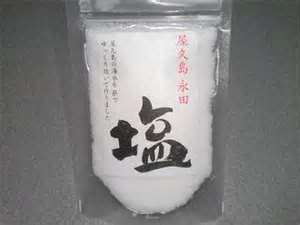 Yakushima sea salt has a sweeter and less harsh flavour than table salt. The main production area is in Nagata where the turtles visit to lay their eggs. A variety of sea salt flavoured cookies and snacks are available in local gift shops, as well as herb flavoured salts of various kinds. The sea salt makes an excellent souvenir as it`s small, light and very distinctive.
Yakushima sea salt has a sweeter and less harsh flavour than table salt. The main production area is in Nagata where the turtles visit to lay their eggs. A variety of sea salt flavoured cookies and snacks are available in local gift shops, as well as herb flavoured salts of various kinds. The sea salt makes an excellent souvenir as it`s small, light and very distinctive.


